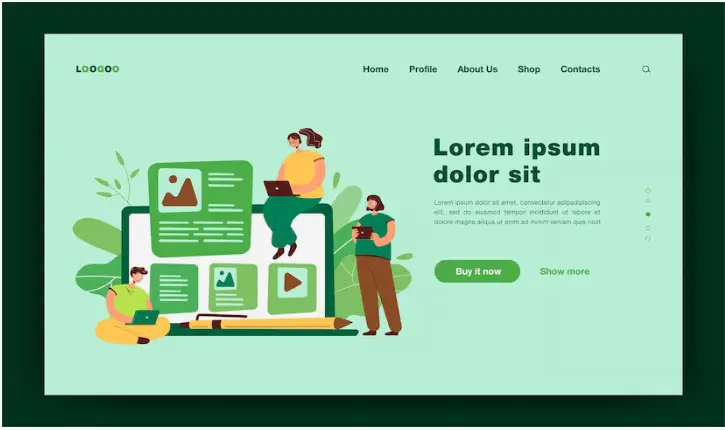Every day on the web, more than 4.4 million blog posts are published. So if you want to stand out from the crowd, it’s essential to adopt good practices to make your blog a real visibility tool.
Unfortunately, there’s no magic trick to writing the perfect blog post. However, if you get creative and follow the tips outlined below you will soon become a real expert in web writing.
Creating an editorial line will make the job of creating and writing content for your business blog easier.
Think content quality before SEO

Writing a good blog post, both powerful and exciting, means first taking the time to work on your topic.
It must be both captivating and based on solid sources. Don’t forget that the articles you write reflect your know-how, your expertise, and your professionalism.
Increasing traffic to your online blog is important, generating a qualified audience is even more important.
You have to stop writing for Google, writing to reach position 0, creating articles to be on the first page. It doesn’t work and it’s even counterproductive.
The only result you will get is an article that looks like all the others, that will be lost in a mass of stereotyped content that nobody wants to read anymore. Your only obligation is to treat the subject in depth so that it responds to the web users’ requests.
Creating an editorial line and a publication schedule will facilitate the editorial work and the continuity of the subjects for the readers.
Now that this basic principle is established, discover some techniques and tips to write a quality blog post that will be read and shared by your community.
Make sure the title of your blog post is accurate

The title of your blog post is an essential element in web writing. Indeed, it is the title and only the title that will push the user to click on your content and not on another one.
The title of your article must be as catchy as possible without being racy.
Thus, your title must be both :
- Visible: placed at the top of your article and perfectly identifiable.
- Concise: it must be short and clearly define what you are going to talk about.
- Storytelling: it must invite the reader to read and make him/her want to know more.
- Referenced: your title must contain keywords that will help search engines index your article.
12 tips for writing a good article title

The art of writing the perfect blog title is not just about storytelling. It should of course be free of spelling mistakes, but it should also follow these few basic rules:
- It must be short (maximum 550 pixels or about 70 characters) to be displayed in full in the SERPs;
- It must contain at least one of your keywords;
- Your title must translate exactly the content of your article;
- It is written without any mistake;
- It must be catchy to encourage clicks;
- Your title must of course be unique (used only once on your website);
- Finally, it must be detailed enough for the Internet user to immediately understand the subject.
1. Captivate the reader from the introduction of your article
Reading a blog post is almost like buying an apartment. Everything happens in the first 30 seconds.
It’s from the introduction of your article that you will hook your readers, put them on the edge of their seats, make them want to go further, and take them to the end of your subject.
Capturing your readers by writing powerful introductions is essential in a content marketing strategy.
The first basic rule for writing a good introduction is to always write it last, once your article is finalized, structured, organized.
This introduction covers the main elements of the article: it announces your subject, it is brief, it gets straight to the point!
You can classically use the good old 5W technique: Who? What? Where? When? Why? But there are many other techniques to write a catchy and original title:
- Use storytelling like no one else: imagine your introduction as a story that you will tell to people;
- Surprise your readers: start your subject with an anecdote, a witticism, a bit of humor;
- Give a shocking piece of information in the first few lines: an important fact, a statistic, a figure, a quote, etc.
2. Adopt a writing style adapted to the web
A good blog post is one that is read to the end. And to be read, it must be perfectly written. But on the web, the rules of writing are totally different from those of the press or the book.
Never forget that your article is going to be viewed on a computer screen, on an iPad, or on a phone. And it’s no secret if we tell you that on a screen, you don’t read at all the same way as in a book or newspaper.
Internet users tend to pick up the information that interests them. They often want to find the answer to their question immediately and they don’t necessarily have the time to stay in front of their screen for an hour, as they would with a good book.
So here are some basic writing tips for creating effective and efficient web content:
- Structure your article into multiple paragraphs and sub-sections;
- Use titles and headings;
- Never use the content of others;
- Use short sentences (one sentence = one idea);
- Use a direct style and a concise vocabulary;
- Always adapt the tone of the article to your readers, to your target;
- Forget about scientific, legal or commercial jargon, think about making your words as simple as possible.
- Always be creative.
3. Don’t forget that attention on the web is reduced

Thanks to eye-tracking techniques, some scientists have been able to highlight the reading habits of Internet users. In 2006, Jakob Nielsen succeeded in modeling F-reading.
When an Internet user consults an article or a web page, he will generally scan the entire content, focusing on the titles and the beginning of the paragraphs. He then tends to scroll, then starts again at each part.
That’s why your blog posts should contain many sub-parts punctuated with headings, sub-headings, and bulleted lists that will catch the readers’ eye.
4. SEO: optimize your text for Google
What about SEO in all this? A good blog post is an article whose SEO is perfectly in place and above all that is not noticeable.
You may not have known it, but SEO is an art that does not only consist in including those famous keywords that will seduce Google. So here are some wise and practical tips for integrating SEO into your blog posts.
If you are using a blog hosted on the most used CMS, don’t hesitate to follow this advice and the different steps of SEO for a WordPress site.
5. Choose the right keywords for your article for SEO

Today, generic keywords have become so competitive that it is very complicated to be well-positioned on this type of request. To get around this problem of competition, it is recommended to work on key expressions or long-tail keywords.
Let’s take an example:
- Generic word: blog (11 730 000 000 results)
- Key phrase: blog post (4,720,000,000 results)
- Long tail query: write a blog post (79,600,000 results)
You vote that the number of results for the generic keyword is almost 150 times higher than that of the long-tail query. It will therefore naturally be much easier to position yourself on the latter than on a too general expression.
6. Use H1 to H6 tags to structure your web content
The H1 to H6 header tags allow you to organize your titles in order of importance.
Let’s start with the H1 tag, which is the main title of your article by default. It must be used only once and absolutely contain your keyword or expression.
You will then use H2 tags for the titles of your paragraphs. You can also organize your paragraphs into subsections, using an H3 tag. Finally, you can further prioritize the information by adding the H4, H5, or H6 tags.
7. Work on your lexical field
In natural referencing today, it is very important to work on the semantics and the lexical field of your subject.
To be able to propose more and more qualitative content to its readers, Google is able to recognize all the lexical fields, as well as the synonyms related to a keyword or a subject.
It may therefore be interesting, rather than practicing what is called keyword stuffing, to take an interest in the semantic optimization of web content.
To do this, you just have to do a Google search around the semantic field of your subject or use the various online tools available like YourTextGuru,
8. Find the right length to write the perfect article
The great debate on the ideal length of a blog post is still going on. If currently, the trend is clearly towards the long format (between 1500 and 3000 words) which seems to perform better than other types of content, you still need to think about your articles in terms of audience and medium.
Indeed, if your audience is young and 100% mobile, they will not consume the same type of content as an audience of 30 – 40 years old who consult your blog on a computer.
Moreover, if your article deals with a news item or a simple subject that does not require long explanations, there is no need to write a very long blog post.
The risk, in this case, would be to lose the interest of the reader who would quickly leave the page and increase its bounce rate.
9. Don’t forget to optimize your images too

Finally, here is one last thing to remember. At a time when a visual search has taken on unprecedented importance, don’t forget to optimize the content of your images for SEO to make your articles rise in the SERPs.
Remember to rename your files and fill in the description and alt tag of the image, including your keywords if possible. If you don’t have the possibility to create your own illustrations, you can get images on the most famous image banks.
Now you have all the tools you need to write compelling, SEO-optimized articles. All you have to do is get to work to make your website a content machine that will attract a new audience and keep your readers coming back.
Over time, these contents will have to be updated in order to remain interesting for the readers and keep their SEO powers.
10. Add videos to your content
Using video in your content brings added value to the reader. Media in general and video, in particular, allow you to complete the usual textual editorial strategy and capture the attention of visitors with more entertaining video formats.
11. Write evergreen content
Writing evergreen content means writing informative texts whose information does not become obsolete with time.
Unlike news articles that have a limited interest in time and become irrelevant, evergreen content stands the test of time and remains relevant for a long time.
They are important to maintain a perennial content strategy over time.
12. Pay attention to readability and spelling
The readability and quality of your publications are important for the reader and your brand image. Don’t hesitate to use spell checkers to check for errors in your publications and correct any mistakes that have escaped your attention.

